The artist and photographer Warwick Saint (born in South Africa, lives and works in Miami) shares his philosophy of light in relation to the use of innovative technologies and media techniques, approaching a new frontier of artistic investigation.
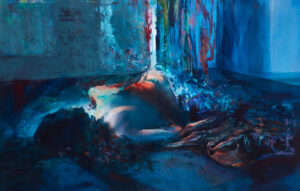
Warwick Saint, “Form Longing for Formless”, 2022. Mixed media acrylic on canvas, 40” x 60”, courtesy the artist
Sara Buoso: You were born in South Africa as a child of art: your mother was a famous model and your father was an accomplished graphic artist who painted with an airbrush. Then, you grew up and trained in South Africa, Sweden, the UK and the US. Given your education, how have all these different contexts affected your understanding of light and your images?
Warwick Saint: Africa is a place rich in culture: there are many extremes there. Growing up in South Africa, there is nothing more beautiful than being under the African sky and seeing a sunset: it is so powerful and majestic. Many of my early experiences were spent in the forests where the light is bright and the sunsets are golden orange. Cape Town meets the Atlantic Ocean and the Indian Ocean, creating a dynamic climate. So, appreciation for the majesty and epicity of light has been imbued in my DNA since I was a child. This is how I approach my work because I want it to be beautiful and bigger than life. When I was 21 years old, I moved to London where the environment is completely different: the atmosphere in London in the early 90’s was incredible as far as photography was concerned: it was before Photoshop was invented and there were magazines like Dazed & Confused, ID, the Arena, the Zeitgeist. The energy on the streets of London and in the photographic industry was about being specialized, at the forefront, the goal was to push boundaries beyond what photography could achieve with technological means, like the ability to bring the flash to the place. Then, I moved to New York, and one of the things I felt most comfortable with was the sense of scale and proportion. I did a famous photo shoot for the New York Times Magazine, a fashion story using this interesting lighting technique consisting of a flash and a double exposure, a juxtaposition of studio and natural light, merging them together on the same frame. I always want something epic and beautiful. I have always pushed photography as far as possible, towards a new genre that now includes painting using mixed techniques.
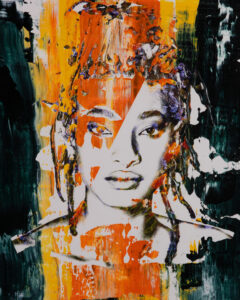
Warwick Saint, “Masking of Innocence”, 2019, mixed media, 16” x 22”, courtesy the artist
Your contribution to the techniques of photographic language is remarkable: you can claim innovative techniques that you have coined in terms of strobe, long exposure, kinetic silhouettes, natural light, SDF mix, OFTE, sound and high speed photography, just to name a few, and now you are experimenting with light painting for which there is no exact definition. What is your definition of this mixed practice?
I’m in mixed media exploration, it’s my main focus now though it’s a practice I’ve been following since 2018. It’s a new frontier for me. I am interested in exploring eros and relationships through long exposure techniques. I “paint” them with a long exposure and with different colors of light, then mold them and repaint the paintings with real paint. But in the end photography is painting with light, whatever you do.
It seems a reconciliation, as if painting allows you to take time and dialogue.
When you take a photograph, it’s like you’re creating a dialogue between yourself and the subject, a dance. I’m influencing the subject and the subject is influencing me. I am of the philosophy that a technique never gets the authentic emotion that you are trying to express in an image. On the contrary, the painter does not necessarily deal with techniques, as for music: it is only pure expression. In a photographic process with a subject, there is a relationship that I orchestrate, a scenario, a theme, a space where the subject can do something authentic and evoke some kind of emotion that then, I can capture in a meticulous and detailed way. There is also another report when I take the result of that report and choose the images and print them on canvas. But there is also a moment of deconstruction and disfigurement that allows me to push the boundaries of photography and painting into a new form. It is a powerful experience and there is always a physicality in the work, a sense of performance, emotion and beauty related to the idea of photography. I’m opening a portal of timelessness and, ultimately, this is what photography is. In painting it works differently. An artist rides the waves of creativity, and this becomes an immediate experience, kinetic, physical and expressive. There’s the canvas, and I can get in, cut it, rip it open, throw paint on it, destroy it. I can see where the general compositions of light are. And then again, I enter and do my brushstrokes, and it becomes this process of entering and taking a step back to take photography beyond, through the kinetic immediacy, the physicality of the brush and the painting on canvas. It’s like rekindling photography with enamels, paints, colours, lights and shadows: my version of chiaroscuro.
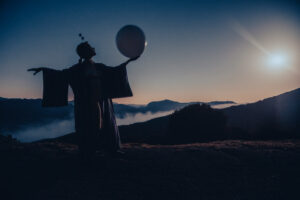
Warwick Saint, “Full Moon and Balloon”. Camera: Canon 5Ds, Location: Topanga, CA, courtesy the artist
What historical references still play an important role for you?
My mentality is to look at my environment and draw inspiration from it. I always look for composition, wherever I look in the world. When I’m taking a shot, for example, suddenly I can have two references coming together, and this juxtaposition becomes a new idea. That’s the beauty of photography. In terms of artistic practices, Francis Bacon had an important influence in my work. But also Picasso, with his series of multiple points of view and his cubist vision of more spaces and the compression of time in a painting. This is exactly what I love about photography, the way we use the camera as a tool to express time in a way we wouldn’t normally be able to do. Photography is really a portal for eternity, as long as that image is available: the way you can expand and compress time with the camera interests me a lot. I like Jackson Pollock’s abstract expressionism: his sense of energetic abandonment and the incorporation of what is now called “mixed media”. As for photographic language, a great reference is Harold Edgerton, particularly his book Stopping Time (1987). I have always loved Helmut Newton for his class, his noble simplicity and his incredible ability to evoke scenes and scenarios. In addition, Richard Avedon had an influence on me in terms of emotion: his book In the American West (1985) was an inspiration to me with his portraits capable of conveying authenticity, innocence and truth.
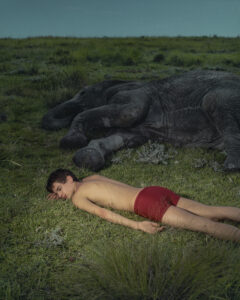
Warwick Saint, “Sleeping with the Elephant”, 1998. Camera: Pentax 6×7, courtesy the artist
Would you like to deepen your perception of time as an artist and photographer?
We live in a world where time is accelerating, it’s relative and not completely linear. It might be linear in terms of sequential time, but there are two properties of time and they derive from two Greek words. Chronos is sequential time, a quantitative description of linear time, but my favorite word is Kairos, the qualitative aspect of time, which refers to the choice to perform the appropriate action at the appropriate time. This is the most interesting. With technology, we experiment with photos much faster, and I think that to create art you need to slow down, look for that extra moment, and that’s where the value and significance of a great photograph lie. That’s why I love the idea of slow motion, stop motion and time compression in a composition. There’s an interesting kind of work called “parallax” that’s not a movie, it’s not a video, it’s not a still image. It’s in the middle of these. It is a static photograph, but there is a movement with the background in the foreground that deceives your mind and forces you to stop because it represents time in a way that is not normally experienced.
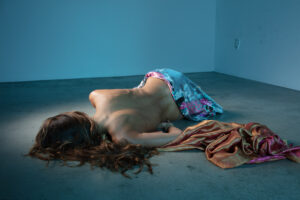
Warwick Saint, Lumascape photo for “Form Longing for Formless”, 2022, 40” x 60”, courtesy the artist
Even if you are not using a camera as we speak, you have shared an interesting mental image: your idea of beauty and the image of art and photography as portals. Could you explain it better?
There is a depth to beauty, which I believe every human being has within him, no matter how aesthetically pleasing or not. My exploration as an artist is to work with technology to push me towards unattainable ideas of beauty and play with the dynamics and psychological complexities, to create something that is beautiful, deconstructing and abstracting it through painting. A large work of art or a large photograph is a portal that evokes emotional energy. When you look at an image, there is an emotional current, open to that moment in time and transmitted to the viewer. It is essential to contradict and counteract the technological advances of artificial intelligence and the speed with which images continually reach us, introducing the human experience. Artists have a unique opportunity to preserve and transmit what is uniquely human.
Info:

She is interested in the visual, verbal and textual aspects of the Modern Contemporary Arts. From historical-artistic studies at the Cà Foscari University, Venice, she has specialized in teaching and curatorial practice at the IED, Rome, and Christie’s London. The field of her research activity focuses on the theme of Light from the 1950s to current times, ontologically considering artistic, phenomenological and visual innovation aspects.






NO COMMENT